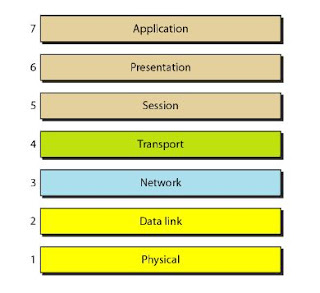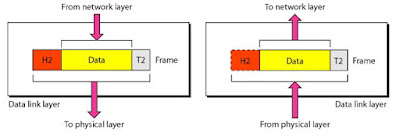THE OSI MODEL
- Established in 1947, the International Standards Organization (ISO) is a multinational body dedicated to worldwide agreement on international standards.
- An ISO standard that covers all aspects of network communications is the Open Systems Interconnection (OSI) model. It was first introduced in the late 1970's.
- The open system is the set of protocols that allows any two different systems to communicate without regarding of their underlying architecture (h/w and s/w).
Note
ISO is the organization.
OSI is the model.
Seven layers of the OSI model
The interaction between layers in the OSI model
An exchange of data using the OSI model
LAYERS IN THE OSI MODEL
In this section we briefly describe the functions of each layer in the OSI model.
Topics discussed in this section:
- Physical Layer
- Data Link Layer
- Network Layer
- Transport Layer
- Session Layer
- Presentation Layer
- Application Layer
PHYSICAL LAYER
The physical layer is responsible for movements of individual bits from one hop (node) to the next.
The major functionalities of physical layer are:
- Physical characteristics of interfaces and medium
- Representation of bits
- Data rate
- Synchronization of bits
- Line configuration
- Physical Topology
- Transmission mode
DATA LINK LAYER
The data link layer is responsible for moving/sending frames from one hop (node) to the next.
The major functionalities of data link layer are:
- Framming
- Physical addressing
- Flow control
- Error control
- Access control
Physical Addressing
Most local-area networks use a 48-bit (6-byte) physical address written as 12 hexadecimal digits; every byte (2 hexadecimal digits) is separated by a colon, as shown below:
07:01:02:01:2C:4B
A 6-byte (12 hexadecimal digits) physical address.
NETWORK LAYER
The network layer is responsible for the delivery of individual packets from the source host to the destination host.
The major functionalities of Network layer are:
- Routing
- Logical Addressing
- Packet Switching
Source-to-destination delivery
TRANSPORT LAYER
The transport layer is responsible for the delivery of a message from one process to another.
Reliable process-to-process delivery of a message
The major functionalities of Transport layer are:
- Segmentation
- Port addressing
- Flow control
- Error control
SESSION LAYER
The session layer is responsible for dialog control and synchronization.
The major functionalities of Session layer are:
- Synchornization
- Dialog Control
PRESENTATION LAYER
The presentation layer is responsible for translation, compression, and encryption.
APPLICATION LAYER
The application layer is responsible for providing services to the user.
PHYSICAL LAYER
The physical layer is responsible for movements of individual bits from one hop (node) to the next.
The major functionalities of physical layer are:
- Physical characteristics of interfaces and medium
- Representation of bits
- Data rate
- Synchronization of bits
- Line configuration
- Physical Topology
- Transmission mode
DATA LINK LAYER
The data link layer is responsible for moving/sending frames from one hop (node) to the next.
The major functionalities of data link layer are:
- Framming
- Physical addressing
- Flow control
- Error control
- Access control
Physical Addressing
Most local-area networks use a 48-bit (6-byte) physical address written as 12 hexadecimal digits; every byte (2 hexadecimal digits) is separated by a colon, as shown below:
07:01:02:01:2C:4B
A 6-byte (12 hexadecimal digits) physical address.
NETWORK LAYER
The network layer is responsible for the delivery of individual packets from the source host to the destination host.
The major functionalities of Network layer are:
- Routing
- Logical Addressing
- Packet Switching
Source-to-destination delivery
TRANSPORT LAYER
The transport layer is responsible for the delivery of a message from one process to another.
Reliable process-to-process delivery of a message
The major functionalities of Transport layer are:
- Segmentation
- Port addressing
- Flow control
- Error control
SESSION LAYER
The session layer is responsible for dialog control and synchronization.
The major functionalities of Session layer are:
- Synchornization
- Dialog Control
PRESENTATION LAYER
The presentation layer is responsible for translation, compression, and encryption.
APPLICATION LAYER
The application layer is responsible for providing services to the user.













